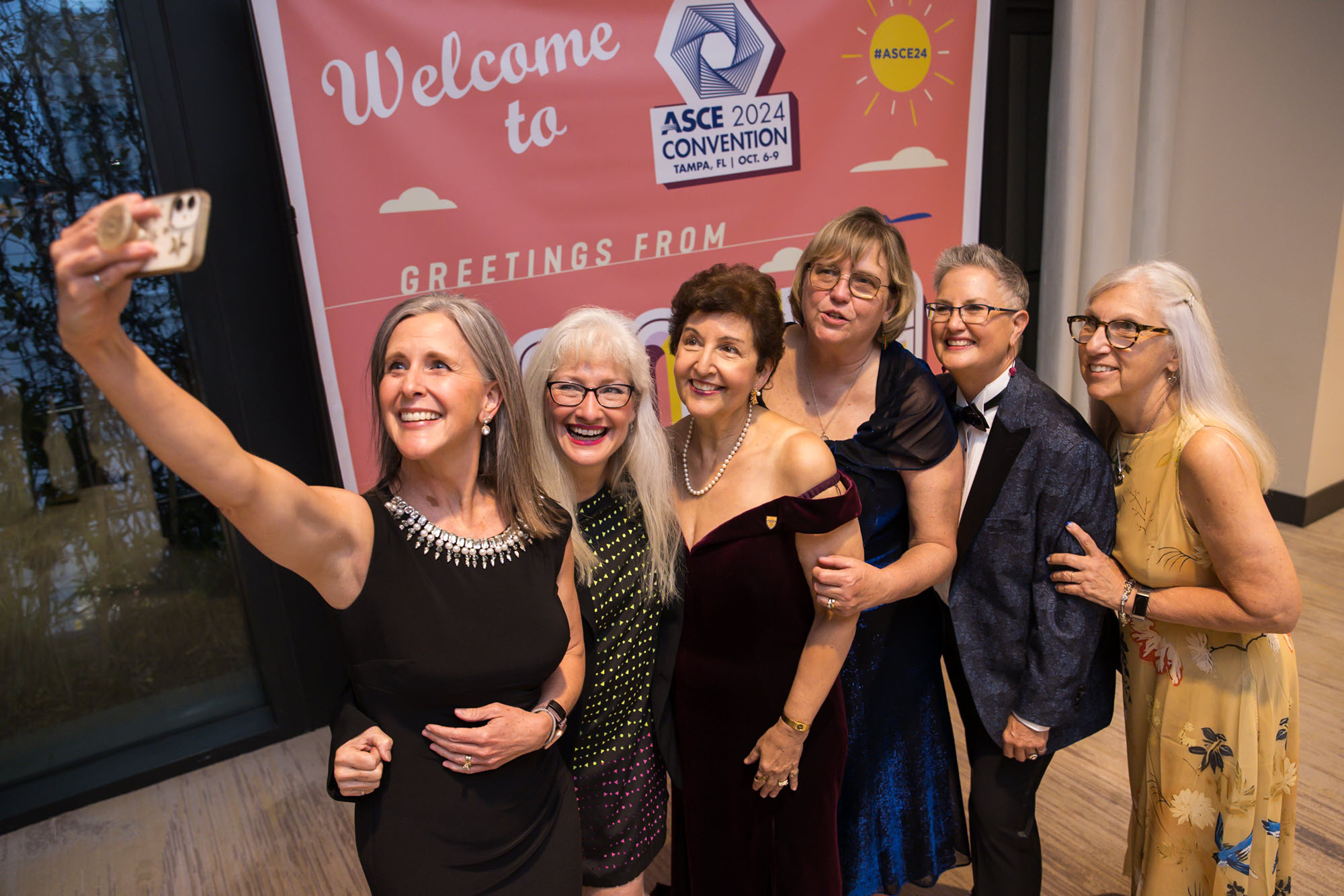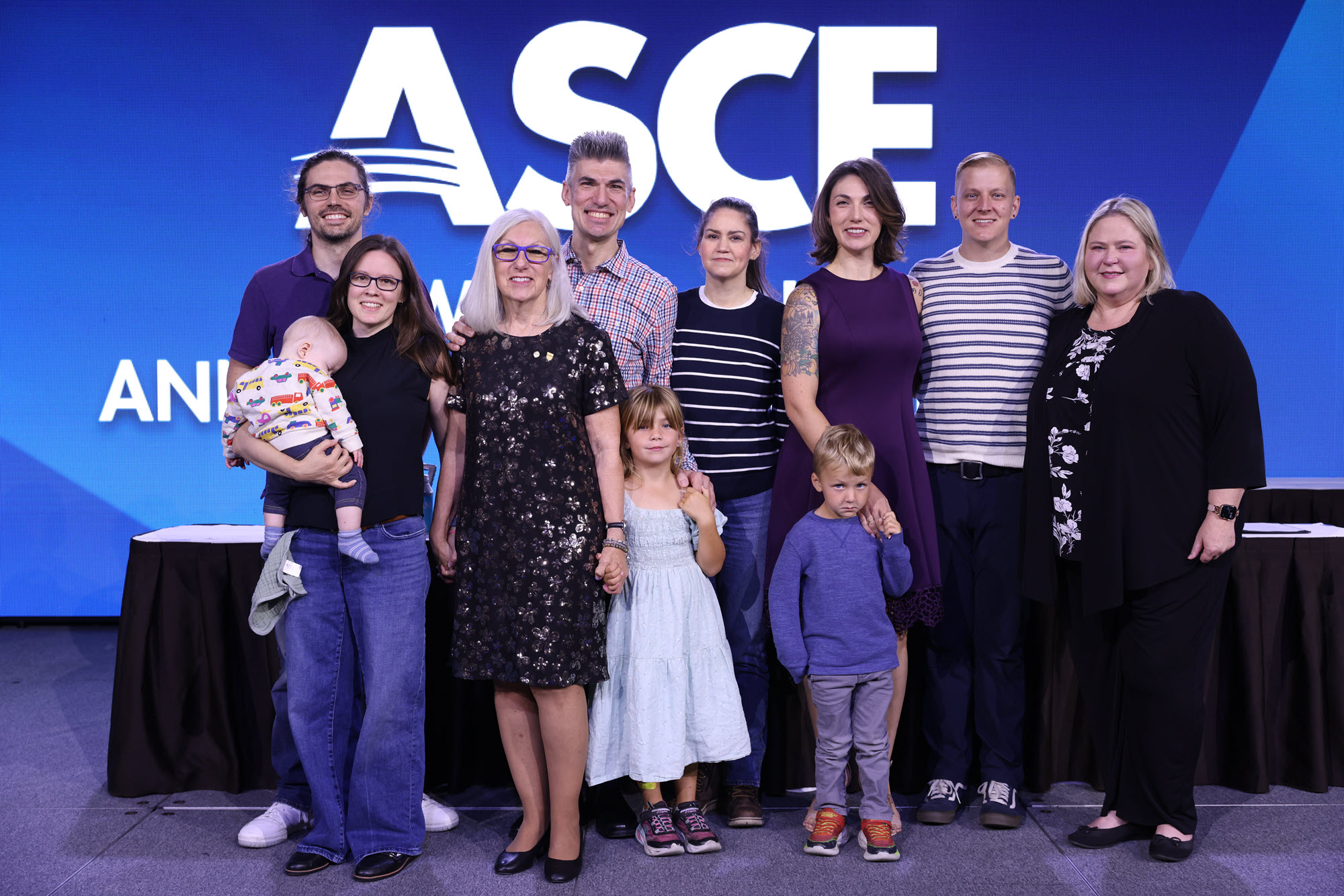 Jason Dixon Photography
Jason Dixon Photography Like many civil engineers, Maureen Merson did plenty of fieldwork early in her career.
But as a woman, she faced some difficult – and dangerous – challenges.
On a project at a previous company, she was responsible for inspecting a construction site with driven piles being lifted by a crane, bringing huge pieces of steel into the air.
“Guys on this particular project were not a fan of having a woman inspect their work and began to make a game of trying to scare me away,” said Merson, M.ASCE, Northeast sales engineer at DYWIDAG. “Usually, the guy operating the loader started to make a game of trying to run me over or swing pieces of steel at me.”
At the time, there weren’t many avenues Merson could use to report the incident and create a better environment. And it can be tough for early-career civil engineers to identify when incidents like what she experienced are outside the norm.
Fortunately, Merson has seen things change. Now, safety measures are stricter, preventing these kinds of incidents from happening not just to women but to anyone on a construction site. There are also more visible women like Merson in the industry.
A ‘boys club’ mentality
Women haven’t always been present in civil engineering leadership roles, and the “if you can’t see me, you can’t be me” issue has long been a major barrier preventing women from entering the field, said Maria Lehman, P.E., ENV SP, NAC, NAE, Pres.23.ASCE, director of U.S. infrastructure at GHD.
Today, there are far more women in civil engineering leadership roles than there were in the past. During Lehman’s year as ASCE president, there was a 50-50 split between men and women on the ASCE Board of Direction.
During her year as past president in 2024, the board was over half women.
Despite these strides, the number of women in civil engineering is still much lower than the number of men. According to the U.S. Bureau of Labor Statistics, women make up only 17% of civil engineers in the United States.
And it’s still “pretty unlikely” that civil engineers will have a boss who is a woman or be surrounded by many women in their careers, said Lehman, who was recently named ASCE interim executive director.
“The positive trend is you’re seeing more and more women in true leadership positions in engineering, which says a lot about the acceptance of women in engineering,” said Marsha Anderson Bomar, Ph.D., AICP, ENV SP, H.ITE, F.ASCE, strategic transport adviser at GHD and ASCE’s current president. “The negative is that there are still not enough women in engineering.”
The lack of women in the industry has created a status quo that can make demographic changes challenging for everyone, said Uma Lakshman, EIT, ENV SP, M.ASCE, a roadway designer at H&H and a 2025 New Face of Civil Engineering.
Work environments – she mentioned construction sites specifically – in civil engineering have long been tailored to men, making it hard for women to break in culturally.
Merson and Lakshman both emphasized the “boys club” mentality that persists in the field.
“That apprenticeship phase is very fieldwork-intensive,” said Merson. On top of the work itself, there is a difference in “how people interact with you based on gender” between school and construction sites, where “there are many more disparities.”
When Merson started her career, she realized that many jobsites did little to accommodate women’s basic needs.
“In the past, you might have seen a women’s port-a-potty on a jobsite once in a blue moon, even though that was an (Occupational Safety and Health Administration) requirement and has been an OSHA requirement,” said Merson.
Now, these necessary accommodations are much more common, and there are stronger support networks for woman engineers. At DYWIDAG, Maureen is an active member of the firm's Women in Business Network, which was created to promote equality across the organization.
Even with improvements like this, the boys club culture is still challenging for women to navigate, and changing demographics can be tough for established male civil engineers as well.
“You see a lot of people who have been in authority for longer with all these different reputations,” said Lakshman. “They started their careers when women traditionally didn't hold roles in the (engineering) workforce, so it's also a transition for them, which has been complicated.”
A ‘leaky pipeline’
Part of what keeps the number of women in civil engineering so low is what Anderson Bomar described as a “very, very leaky pipeline.” Oftentimes, she said, women in the field leave after around a decade into their careers to pursue other options.
This shift is in part caused by family responsibilities. While some women might choose to focus solely on a career, others might “choose to spend their time a little differently,” focusing on family, children, or supporting elderly parents, said Anderson Bomar.
 Jason Dixon Photography
Jason Dixon Photography Starting a family doesn’t mean women need to give up their careers, but “family-unfriendly” companies that do not leave room for flexibility can make it challenging for women to have both.
Anderson Bomar encountered this issue shortly after the birth of her third child in 1990, when she was told that having three children meant she was not serious about her career and would not have opportunities for advancement.
As a solution, she started her own company and prioritized flexibility within the organization.
“My goal was to have creative rules and show that you could be successful as a business while operating with rules where you recognize people have lives outside of work,” Anderson Bomar said. “Whether it is to serve as a soccer coach, take care of personal matters, or one of many other activities, it is important to recognize that as people we have different needs at different times. While navigating how we could have a variety of work arrangements, we still produced high-quality work and thrived as a business.”
Even before remote work became prominent, her organization offered split days. She also accepted feedback from employees on what worked best for them.
Another factor causing women to leave the field is the opportunities that an engineering degree and P.E. certification open across many industries, Lehman said.
“It’s a broad-based curriculum; it’s very rigorous. It requires creative problem-solving. It requires being able to concentrate and focus, so there are many other professions that are willing to steal you,” she said.
When civil engineering firms fail to offer what women need to meet their personal needs, other industries – and large companies within them – can swoop in, offering enticing salaries and opportunities for flexibility that they might not be able to pass up.
Several years ago, Lehman helped a CEO of a small business in Colorado recruit more women and minorities. They were able to bring an “awesome” woman who was passionate about the work of the team.
But after around a year, the employee received a lucrative job offer from a large technology company that, with student loans hanging over her head, she couldn’t pass up. And the small engineering firm couldn’t compete.
Lehman advised the CEO to remain in contact with the employee even after she left, to leave open the option to come back later. In Lehman’s career, maintaining a relationship with a past public sector employer led her back to the organization after some time in consulting.
Retaining women comes down to making sure individuals are “well matched for their personal needs in that season of their life” and giving them interesting projects that draw them back to the profession if they do choose to try something different, Anderson Bomar said.
Is mentorship a path forward?
Mentorship programs are a hot topic in the civil engineering industry, with many firms investing more resources in these programs.
For women, a successful mentorship with a more established woman in the industry can help address the “if you can’t see me, you can’t be me” issue. But “that only goes so far if we don’t actually address the barriers within an institution for that advancement,” Merson said.
At a previous company, Merson experienced “issues with pathways for advancement for women.” Despite the C-suite acknowledging the problem, only one of the vice presidents was a woman.
“I think it’s great that mentorship is currently much more of a visible and talked-about thing,” she said. “There’s more structure to it. It’s more acknowledged. I think mentorship is very critical to giving support and validation.
“I do think there’s this kind of catch in mentorship, though, where other women in civil engineering can be your biggest advocates, can be your best mentors, but can also conversely sometimes be your biggest critics,” she continued.
What this comes from, Merson said, is “survival skills for going through that environment.”
Great mentors can be life-changing, but without taking proper care when pairing mentors and mentees, the benefits of these programs can be lost.
Lakshman experienced a mismatch in one program in which she asked for a woman mentor specifically but was paired with a man.
“I would talk to him about stuff, but he had never been in a similar situation and couldn't relate” she said. “He often encouraged me to let things go, reminding me not to dwell on what I couldn’t control and to stay focused on my own growth.”
She has had positive experiences with male mentors, but when looking for someone with similar experiences, “it’s still not the same as connecting with women.”
One way to solve this problem is with informal mentorships, which can feel more organic and give women more of a say in the type of mentor or mentorship they want.
“It’s really hard to balance formal mentorship programs and natural opportunities,” said Lakshman. “But I think there are ways to merge them, like having a networking mixer with just the women so they can talk and chat.”
Lehman also sees informal mentorships as the best option. Having an extensive network, she said, is the most effective way to access this type of mentorship because it gives civil engineers the opportunity to learn from people with different skill sets and avoid professional repercussions that might occur if they bring an issue to company leadership that doesn’t resonate.
She emphasized the value of in-person work, employee resource groups, and membership organizations in building a network.
Anderson Bomar is a proponent of both structured and informal mentorships, having implemented two formal mentorship programs. What these offer are structured timelines and conversations that might work better for certain people or concerns.
She has also done plenty of informal mentoring, including helping a woman launch her own business.
“There are just a lot of different things that fall under the umbrella of mentor-mentee relationships, but I think they’re very valuable to both parties,” she said.
What’s driving change?
Many industry leaders have recognized the importance of a diverse workforce, especially with the increasing scarcity of civil engineers.
Bringing more women into the field not only increases the number of civil engineers but also the number of perspectives in the industry.
“As engineers, we solve problems, so we’re dealing with problems day-to-day,” Merson said. “And I think everyone pretty much acknowledges that problem-solving is better when you bring more perspectives.”
Lehman recounted a time while serving on New York’s State Emergency Response Commission when she was faced with a 6-foot hole that appeared on a bridge deck. The bridge did not handle much traffic – only around 1,200 cars per day – but was part of a school bus route.
“That’s an emergency to me. I don’t want kids on a school bus for three hours,” she said.
Her perspective drove the team to act more urgently than it might have otherwise.
“Being a mom and having kids on school buses, I started thinking: What does this mean? And what really is the critical problem to solve?” said Lehman. “So, I think women bring a very different perspective to that.”
Despite some persistent challenges, Anderson Bomar sees a marked change from the “very different” world of her early career, where she strived for – and achieved – many firsts for women in civil engineering.
Now that there are more women in the field, she said, those in leadership roles “need to be lifting others up – anyone who is interested, anybody who is underrepresented, or needs a helping hand.”
“I can’t tell you how different the board of ASCE was between 2022 and 2023 – the level of debate, the conversations, what was important to the board, what was in the strategic planning process,” said Lehman.
Going from a minority woman board to an equal one and then to a majority brought a shift in priorities, a “breath of fresh air” for Lehman.
“Seeing women in leadership roles is very important to the next generation of leadership because it establishes that there is a career path, that there is opportunity, and that success can be yours if you’re at a point in your career or a stage in your life where you’re questioning that,” said Merson.
Explore more Civil Engineering Source content on YouTube Shorts



